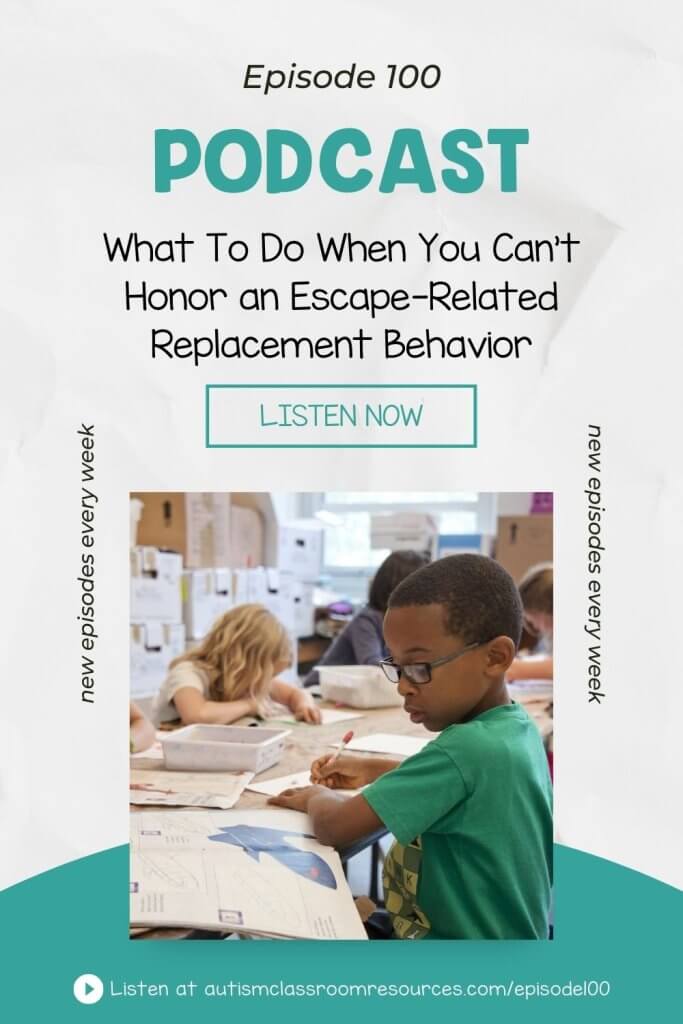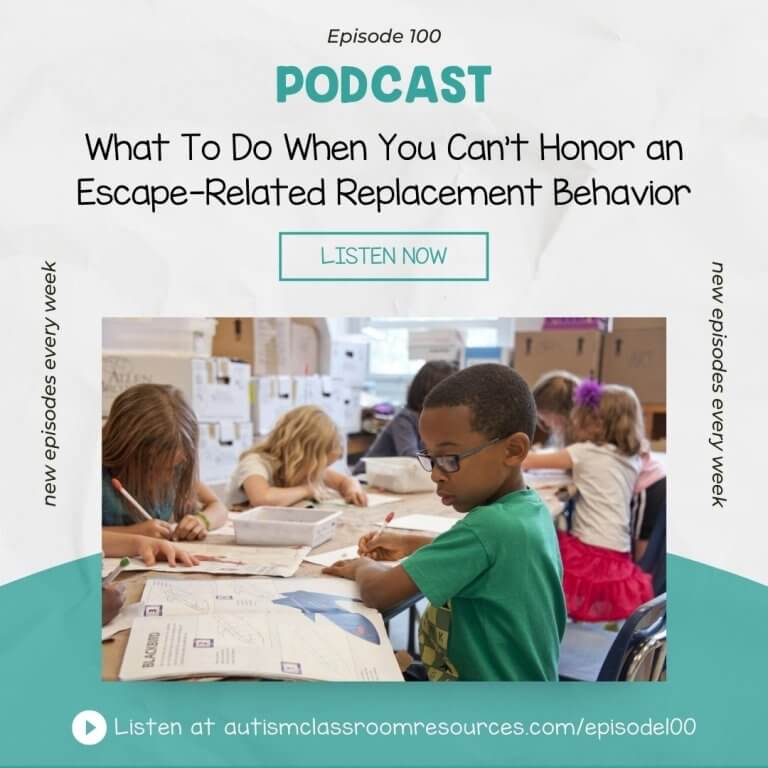Welcome to the Autism Classroom Resources Podcast, the podcast for special educators who are looking for personal and professional development.
Christine Reeve: I’m your host, Dr. Christine Reeve. For more than 20 years, I’ve worn lots of hats in special education but my real love is helping special educators like you. This podcast will give you tips and ways to implement research-based practices in a practical way in your classroom to make your job easier and more effective.
Welcome back to The Autism Classroom Resources Podcast. I’m Chris Reeve and I’m your host. I’m so glad you’re here. I cannot believe it, today is Episode 100. I cannot believe I have been doing this podcast for that long. Today, I want to start with a quick story, having to do with behavior, which is what we have been talking about recently. Micah is a student who has a history of hitting the teacher and throwing work materials when he is asked to work. The team did a functional behavior assessment and found that the behaviors function to escape from the work demands. Even though the teacher didn’t intend to, the work demands often ended up being put aside or delayed to address the challenging behavior. Part of his behavior plan was to teach Micah a way to escape from work demands more appropriately by asking for a break. This allowed them to remove the work demands for the appropriate communication response, the break asking. Not for the challenging behavior.
As I talked about in Episode 98, they worked on making the communication response more efficient than the hitting and throwing at getting released from the tasks. All of that was fine but Micah’s teacher discovered that she still had situations in which giving him a break just wasn’t an option. Sometimes, he wanted a break from an activity he couldn’t be removed from. For example, sometimes he wanted to leave art or music specials but there wasn’t staff available to actually remove him from the room. This resulted in more hitting and throwing. She was really worried that was going to sabotage the behavior program as a whole. While she could give him breaks when she was with him in her classroom, it wasn’t always possible in other environments. That’s what I want to talk about today. What do you do when you can’t honor the function of the replacement behavior that you’ve chosen?
Today, I’m going to focus on escape-related behavior, then I’ll focus on other functions in the coming weeks. I have a free download, as well as a free behavior webinar that I want to share with you in this episode. If you find yourself with these kinds of questions as you’re trying to manage behavior in the classroom, you may want to check out the Behavioral Problem Solving course in the Special Educator Academy. It’s a whole course that will actually walk you through, doing the functional assessment and collecting the data, providing behavioral support. All of it is really focused on how we make this fit and work in the context of a real life classroom, and real life situations. You can try it out with a seven-day free trial. Just hop over to specialeducatoracademy.com and you can join us because teaching in special education does not need to feel like you live on an island. Now, let’s get started.
In Episode 98, I talked about the most critical elements of choosing replacement behaviors for challenging behaviors. One of the things is making sure that the replacement behavior that we’re building is better at getting reinforcement than the problem behavior. Part of that depends on how we respond to the problem behavior and part of it is how we respond to the replacement behavior. In a perfect world, we would always respond to the challenging behavior by not letting the student escape from the task and always allowing him to escape when he asks for a break or whatever our replacement behavior is but we don’t really live in that perfect world. We live in the real world. It doesn’t work that way. There are always going to be times when we just can’t let him leave something, like Micah just can’t leave a special when there’s no one there to supervise him or can’t leave a fire drill when we’re in the middle of it.
In those cases, we need to put some preventive strategies in place that will make it less likely that Micah will want to get out of the situation. We want to do some things that are going to decrease his need and his desire for escape. Some of these will depend on the student, in our case, on Micah and why he wants to get out of that situation. For instance, if you know that he wants to leave a situation because it’s too loud, that might mean getting him to wear headphones when he goes there. If you know that it’s because he has a hard time sitting still, it might be letting him wander the room instead of staying in his seat. Overall, you’re going to want to get creative. These aren’t the only options. The ones I’m going to give you today are not the only ones. Behavioral support is a lot about creative thinking and brainstorming. It’s about putting yourself in the student’s shoes in this way as well.
That’s what you’re going to want to do here but if the issue is task demands, here are five things that you may want to try. One, decrease task demands. Now, I get that it seems really simplistic but sometimes, the simplest answer is the best. If you know that the student is struggling and that challenging work precedes break requests or challenging behavior, then decreasing test demands and using more maintenance tasks is a way to keep them engaged in the activity without triggering break requests or escape behaviors. Now obviously, this isn’t one that we want to use all the time but it is one that you could use occasionally when you’re short staffed or when you don’t have other options or when maintenance tests are okay. Sometimes, practicing materials is important.
Number two, turn on the high octane task mix. Now, the high octane task mix is what I call it when you bump up the number of high compliance tasks, usually easy tasks, and you bump down the low compliance tasks or the harder tasks. The student is getting more things right and getting usually more reinforcement. This is a good way to get the student being more successful while still giving him some challenging tasks. You’re not just giving him easy tasks. It’s just not all challenging tasks. It’s giving him confidence. It’s giving him a feeling of success rather than constant feelings of frustration.
The third is that you can just increase the frequency or the power of your reinforcement. This is similar to that high acting mix but instead of changing the tasks, you’re just going to change the way you’re reinforcing. Maybe you’re going to reinforce more often. You’re going to reinforce mastered tasks that you normally might not reinforce as much or you’re going to reinforce things that are mastered, just like you would new material or reinforce prompted responses that you might not typically reinforce or maybe you’re going to reinforce with more powerful reinforcers so that the reinforcer is more potent when you use it or you’re going to give them longer access to the reinforcer. For that same effect, you’re going to make the reinforcer more powerful. You could also make the reinforcers more engaging. Play the reinforcer up by making it more exciting. Make it a surprise by hiding the reinforcer for younger kids. Make them more interesting in some other way by making it a surprise or a lottery or something like that. I’ve got some resources that I’ll share in the links in the blog post of ways that you can do this. You’ll find the blog post at autismclassroomresources.com/episode100.
The fourth thing you can do is you can give choices when you’re presenting the tasks you want to do. Giving choices is a great way to make it more likely that any student will follow through with a task. I’ve done a whole podcast episode on these. You’ll find a free download in the show notes in the Resource Library of a poster to remind staff of different ways that you can give choices that you’re offering. Now obviously, the choice is not do the math problem or go to Disney World. It’s, do you want to do the multiplication problems first or the division problems first? Do you want to do them with a silly pen or wearing a funny hat? Go and make sure that you grab the free poster and the episode with more information about choices that you can use as a preventive strategy, autismclassroomresources.com/episode100. Make sure you grab that there.
Finally, number five is you can really amp up the engagement of the tasks themselves. Pull out the preferred mode for the student’s work. If you know that he likes to work on the computer or you know that he really likes to work on the tablet, let him do his work on that during these times. If you know he has special interests like NASCAR, see if you can develop materials that incorporate that. Make file folder tasks or books that are about that special interest. Find fun and novel ways for him to respond to answering flash cards, like using a pointer or a fly swatter or a flashlight to find the right answer or put the card set on the floor and have him jump on the right answer. Those are all ways that he might be able to get more engaged in those activities and those responses.
All of these options are ways that decrease the motivation to escape from the task by increasing the motivation to remain in the task. You want to think about it as a seesaw. One goes up, the other goes down. That decreases the need for that replacement behavior, like asking for a break that you can’t provide. As I said, there are definitely other options. You could also put an X over the escape visual to show him that it’s not available right now. You could put the escape card on his schedule, so he can see when that’s going to be an option again. I’ll cover some of these other options for other functions in future episodes. In the meantime, I’d really love to hear some of the ways that you’ve dealt with this with your students, so hop on over to the free Facebook group at specialeducatorsconnection.com and join us there, and share those ideas with us. Don’t forget to go over and grab your free choices poster, a transcript, and the free webinar and links at the blog post for this episode at autismclassroomresources.com/episode100. There is a free online on-demand webinar on preventing challenging behavior that covers lots of these types of strategies and more that I’ll also make sure is linked in the show notes. As always, thank you so much for spending this time with me. I hope that you come back next week. I hope this is giving you some ideas of things that you can use in your classroom. I will be talking more about challenging behavior next week. Until then, I will be sitting over here, brainstorming ways to decrease my escape behaviors from writing more podcasts.










